12 accent wall ideas – perfect style updates to convince you that the 90s throwback has returned
Thought accent wall ideas were over? Think again. From color and pattern to artwork and joinery, delight your senses with these playful, on-trend options


Accent wall ideas not only add color and pattern to an overall scheme, but it's a chance to create a certain mood, spark conversation and inject personality. We all want a happy home; one that fills us with joy as soon as we step through the front door, a place to feel relaxed and at peace, to host our favorite people and a design scheme that inspires and invigorates.
If you thought accent and feature walls were over, then we're here to tell you they're far from. Done correctly, an accent wall can be as subtle or as statement as you please. Plus, it's so much more than a roll of wallpaper or contrasting paint idea. Really, it can be whatever you want it to be – a wall of favorite artwork, a pink ceiling, floor-to-ceiling bookcases, murals, a way to zone a space and more. It's a wall that makes your home that little bit happier.
We speak to leading designers who give away their top tips on creating an accent wall.
12 ways to bring accent wall ideas to your scheme
1. Pattern up above paneling
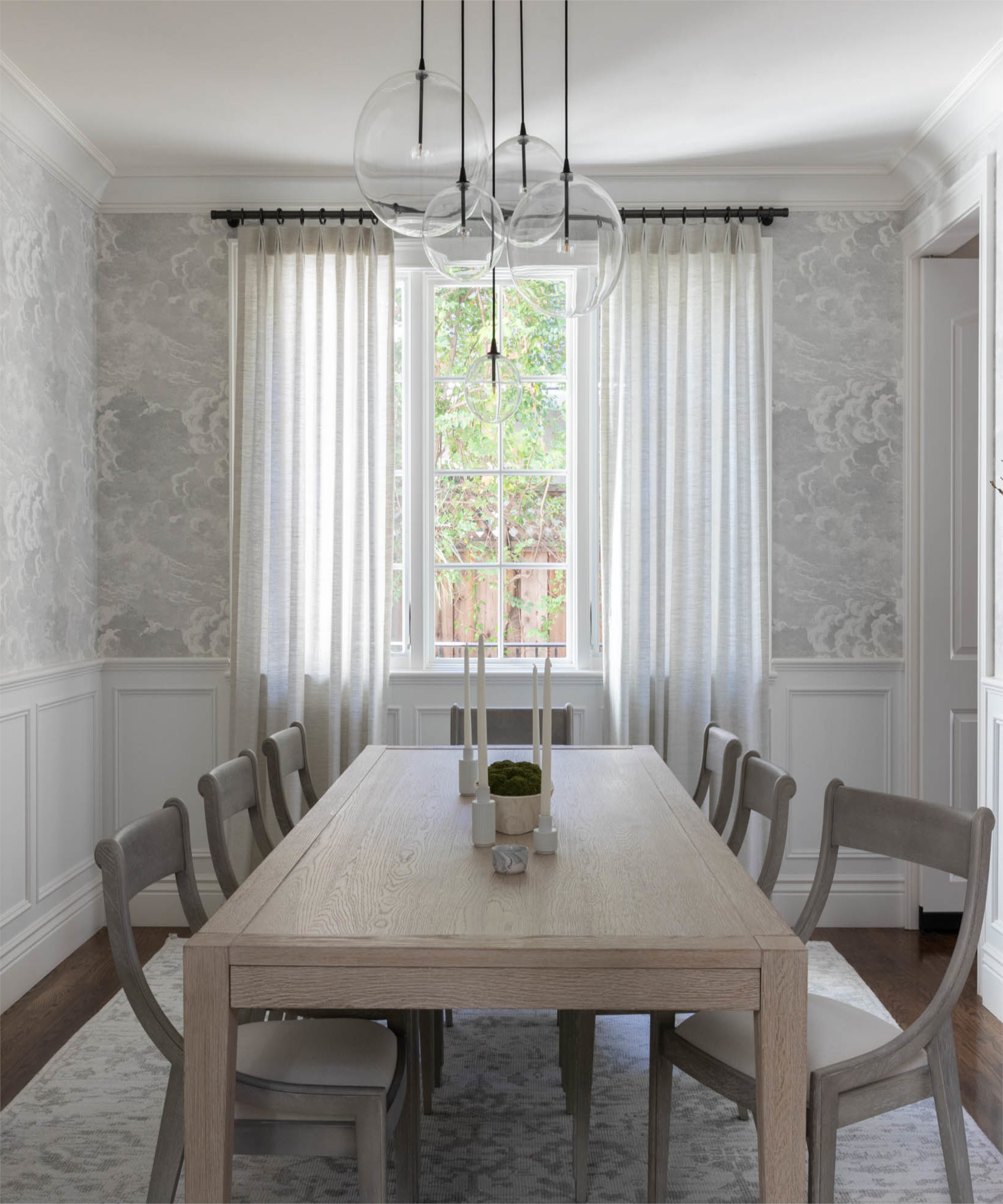
We adore wall paneling ideas and the way they work beautifully in both traditional country manors and modern apartments. They can slot into most rooms, from period hallways and tiny downstairs powder rooms to contemporary living rooms and retro dining rooms. What's more, they can make an excellent accent wall – whether that's one big wall with a secret door, or wainscoting that's updated with accent wallpaper above. Paneling expertly merges the old and new and adds a real feature to a space.
'Accent walls are a pop of color or wallpaper on part of a wall or one or two walls in a room. They give an opportunity to use a cool pattern or bold color in a room without overwhelming the space. They were popular in the 90s and have come back into the design conversation,' says interior designer Susie Novak, founder of Susie Novak Interiors.
'I love this wallpaper but don’t like to overdo it with pattern so here we added it above wainscoting and it really sings and elevates the room. We wanted a beautiful and soothing atmosphere here and wanted to create a formal but also casual vibe!' she adds.
'It’s easy to make an accent wall - you can buy a pot of paint and just paint one wall in a room. Choose the wall that needs some life and is looking sort of dreary,' she continues. 'Pro tip: it doesn’t need to be a bright or bold color. Adding a warm grey to one or two walls can cozy up a room and you can leave the rest of the space white, or like in this picture, wallpaper above wainscoting or make a large rectangle of trim as a frame and makes the wallpaper more of an art piece rather than covering the whole wall.'
The Livingetc newsletters are your inside source for what’s shaping interiors now - and what’s next. Discover trend forecasts, smart style ideas, and curated shopping inspiration that brings design to life. Subscribe today and stay ahead of the curve.
2. Make it personal with art

Art is a fantastic way to create an accent wall. Whether it's one favorite piece that you want to take pride of place or a whole wall of personal photographs, kids' drawings and affordable art, artwork adds personality and character and gives life to a lackluster wall. The soft grey walls of this Tribeca apartment are instantly lifted with these joyful pieces.
'We wanted to create an accent wall that was modern and minimalist,' says Ahmad AbouZanat, founder of New York interior design studio PROJECT AZ. 'The living room has large floor-to-ceiling windows that bring in a lot of light so our approach was to contrast the dark blue sofa with bright colors and add more textures instead of print. The paintings were commissioned to a young artist and we asked for heavy brush strokes. We broke the composition into two with white frames to enhance the minimalist look.'
'Accent walls are almost always in demand. Each project, however, requires a different approach. Some can be just paint (color), wallpaper (pattern, color or texture) or lastly, the use of artwork to create accents that are both visually interesting and more personal, especially to the art enthusiast clientele,' he says.
3. Get creative with color
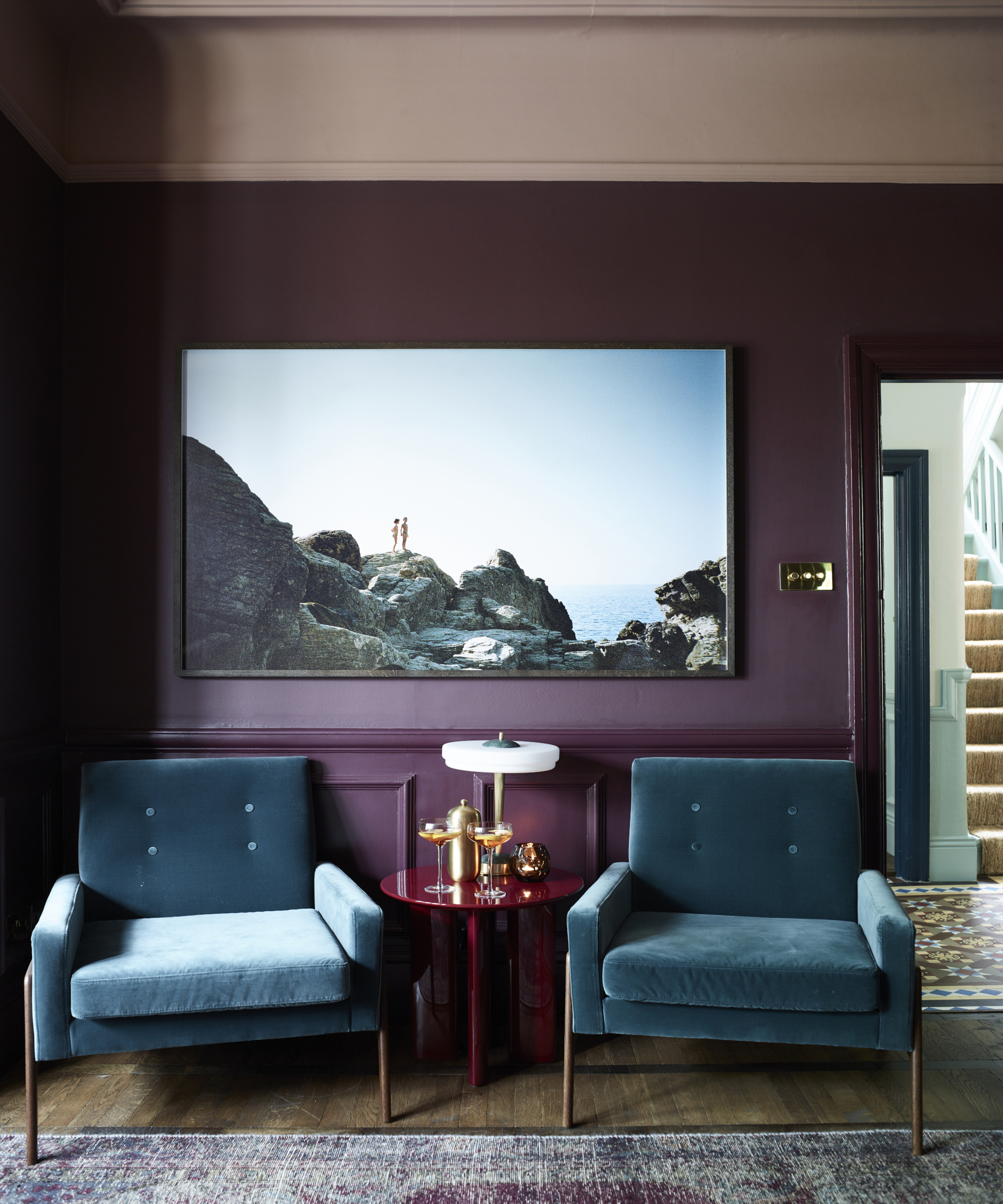
When we think of accent walls, we usually think of bold, bright color trends. A wall that's painted in a different color to the rest of the room. And it's easy to see why - it's a great way to jazz up a space, create a focus and it's affordable. If you change your mind, it's easy enough to paint right over it, even for those lacking in DIY skills.
'As interior designers our challenge is always to create a color palette that is exciting and different, whilst honoring the bones of the home and being liveable for the owners,' says Tiffany Duggan, interior designer and director of Studio Duggan.
Here are Tiffany's top tips when choosing color to create an accent wall:
'Color is key to our mood and how likely we are to feel connected with our homes. If you’re unsure, start by looking at your wardrobe as we’re usually better at expressing ourselves with fashion choices than our homes. Is it a riot of color and pattern? Then you’re probably something of a maximalist! Perhaps there is a more neutral base - jeans, linen shirts and loafers with the odd bright jumper or handbag? If so this is the way you should approach color choices at home.'
'Look at how the light falls and how you want to feel in the space. Where you have natural light in a room primarily used during the day, it makes sense to embrace it, keeping walls fresh and complementing them with natural textures and materials. In a darker north-facing room, a small space, or one in which you are likely to spend the evenings in, don’t be afraid to go warmer/darker. Painting a small, cold space in a bright white, does not have the effect of making it feel larger or brighter - just a little sad. Green is good in a north-facing room (avoid anything with too grey an undertone), or soft pink and nudes. Buttery yellows will make any room feel sunny and happy and are making a comeback. In evening rooms, go for atmospheric and relaxing jewel-box colors - dark emerald green, aubergines, dark red or even a sludgy lacquered brown.'
'I usually paint the cornice in the same color as the ceiling rather than the walls which results in a lighter, more open feel, but occasionally if I want to create a cocooning, moody, feel I flip this and choose a deeper tone for both the walls and cornice. This does have the effect of making a space feel smaller and more intimate, but sometimes this is the right move.'
'If in doubt, be bold! Clients hardly ever regret strong color choices but I am forever being asked how to rectify and inject personality into rather dull characterless spaces. Focus on the room at hand, what will it be used for, and its size and height. To create atmosphere, opt for more intense contrasting shades, and for a calmer space, paint your skirtings, walls, and windows in the same shade. This technique will also create the illusion of a larger room if used in rooms with low ceilings. Finally, consider paint colors alongside fabrics and, if possible, at the same time as adjacent rooms to ensure a sense of cohesion.'
4. Create bespoke joinery
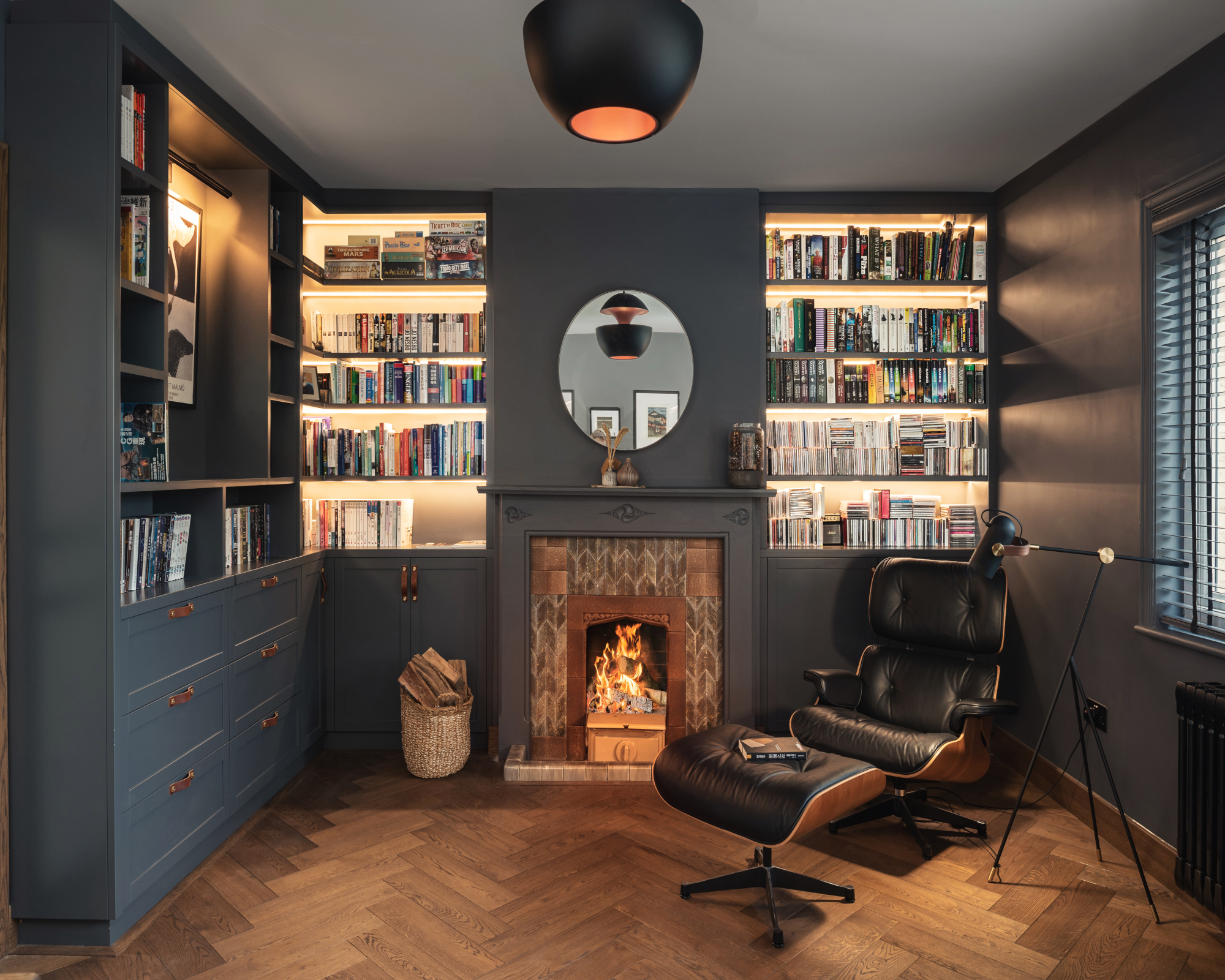
'An accent wall doesn't mean a wall has to have a different color or shade, it could mean using a different design or material from the other walls around it,' says Katie Malik, founder and creative director of Katie Malik Studio. 'In this room, we focused on creating a bespoke joinery design using the same color as the other walls in the room to give it a seamless, masculine mid-century look and feel.'
'Accent walls never go out of fashion, but it's about using design tools to create the unexpected results,' she adds. 'In this space, we wanted to create a dark library feel in mid-century modern style, so instead of using the contrasting color in the joinery design, we opted for the same shade of dark grey from the Benjamin Moore collection which ensured the design fluidity.'
5. Play with pattern
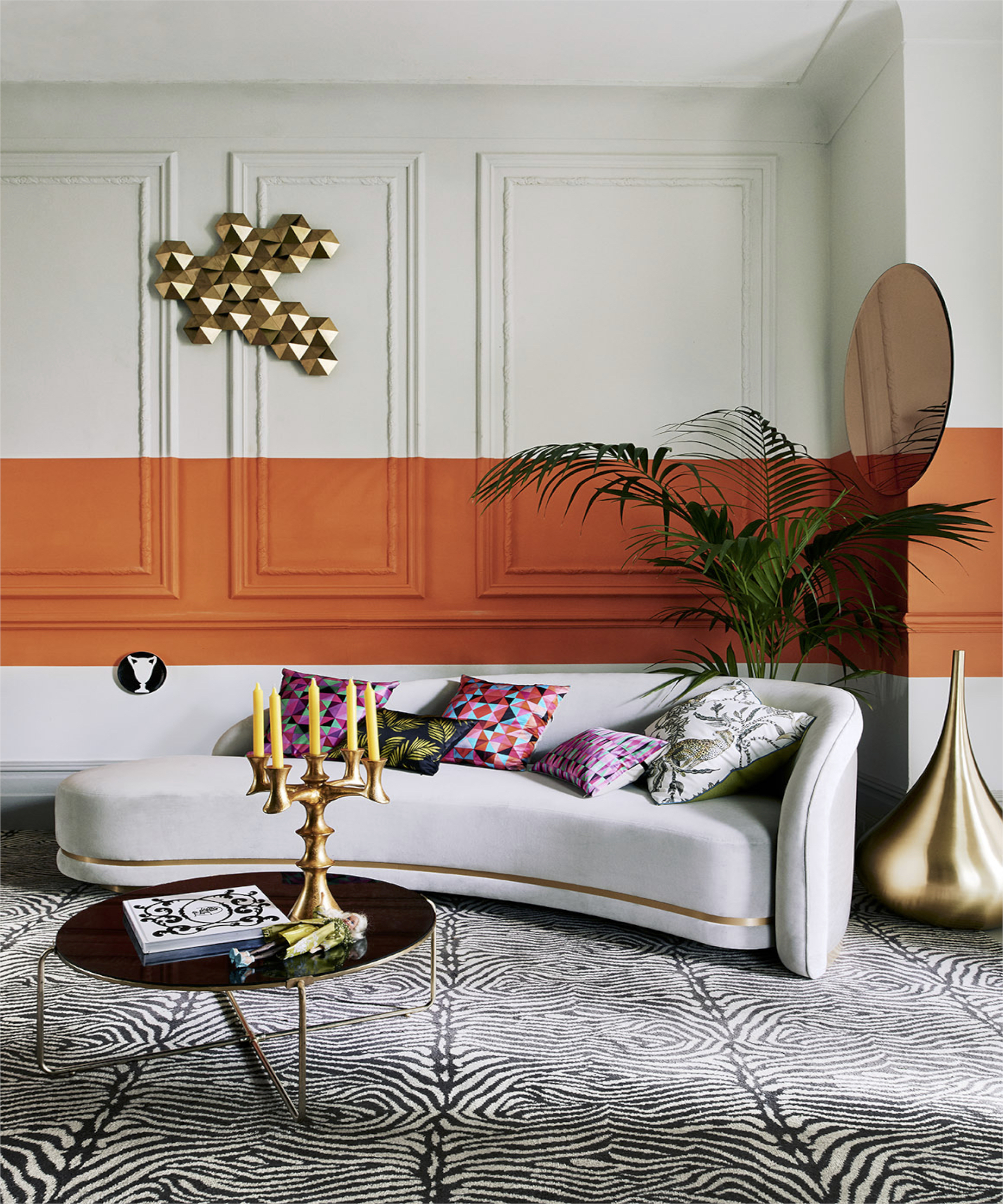
Looking for rule-breaking design ideas? Create your own pattern with paint and the help of masking tape and some vision! This burnt orange stripe painted across a horizontal section of the wall creates a striking and beautifully contemporary accent and makes traditional paneling feel modern and cool. Combined with tones and colors that go with orange, the idea lets the color become the star, without overwhelming the space.
Stripes that go up and down make a room with low ceilings look taller and horizontal stripes give a smaller room a more spacious feel. The thinner the strips, the busier the pattern, too.
Want to give super-crisp straight lines a go? When it comes to how to paint stripes on a wall, give yourself time and patience and start by painting your base color across the entire wall using the lighter and flatter shade of the two colors you picked, advise the experts at FrogTape. Let it dry. Figure out your stripe spacing. Generally, four-12 inches is a good width. For vertical stripes, measure the width of the wall and for horizontal stripes, measure the height of the wall.
Create your outline and mark an “X” where you want your solid stripes to be. Apply the right tape product for your surface and place your tape on the outside of your pencil line so the paint will cover up any markings. Burnish or seal the edges of the tape – run a plastic toll along the tape’s edge so paint can’t bleed through. Pull the tape off when the paint is still wet at a slow, 45-degree angle backward toward the wall.
6. Try an accent material
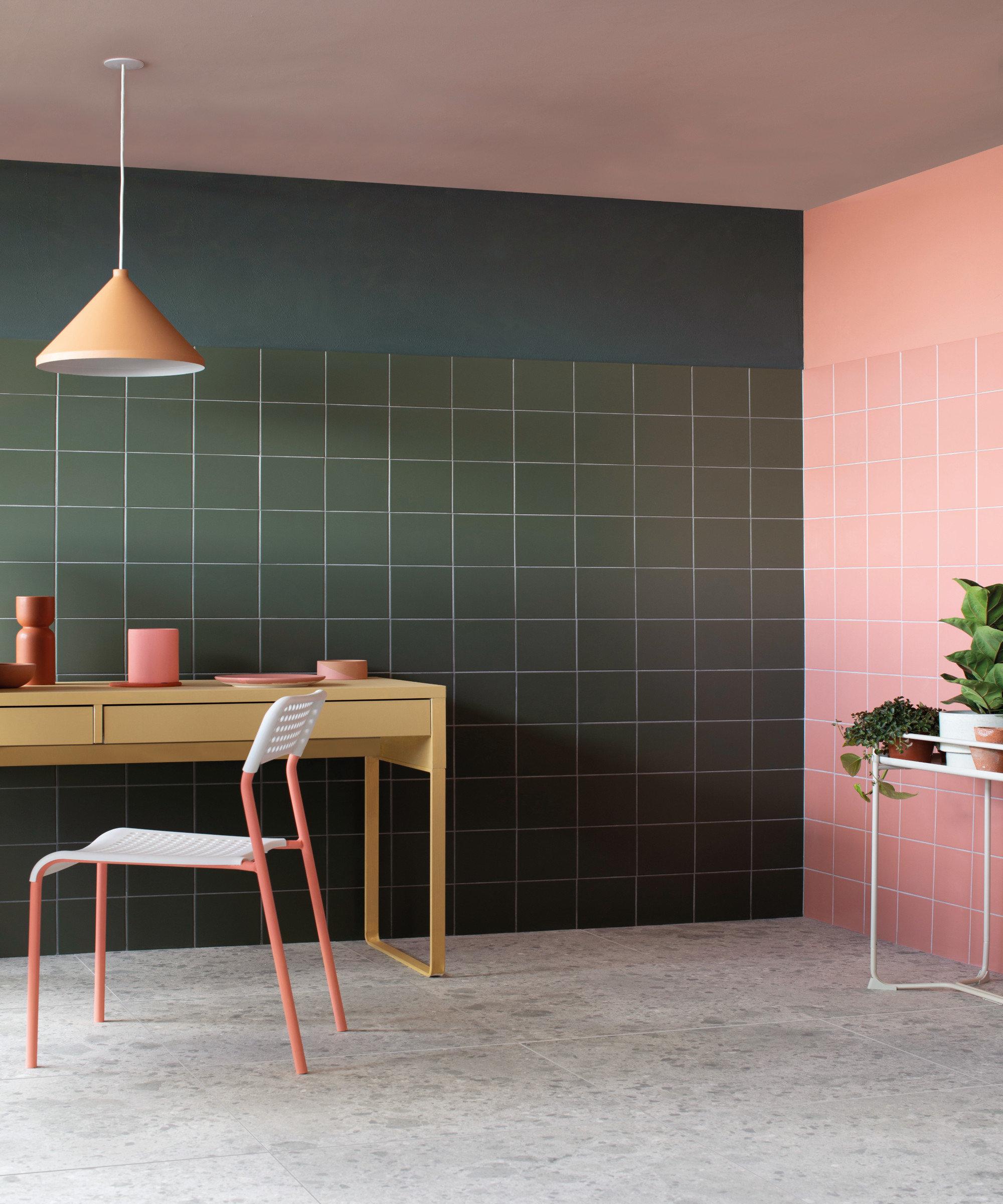
Use a mix of materials and don't fall into that trap of thinking that paint and wallpaper are your only options. You can also create accent walls out of tile, stone, and reclaimed wood.
This scheme cleverly uses tiles in an accent color to help divide an open-plan space, creating a cozy home office corner. 'Go for broke with schemes of punch and pizzazz and use decoration as the main theme in your refurbishment,' says Rob Whitaker, creative director at tile brand Claybrook. 'Tiling a full wall is not only functional for many spaces but creates an aesthetic palette-cleanser from more patterned or decorative schemes by using one color in a block, like the Macaron wall tile pictured.'
'Wood plank was used as an accent material in one of our projects to highlight circulation zones at the perimeter of the house,' adds Thomas Barry, Principal at OPerA Studio Architecture. Working with a room with no direct natural light, the OPerA Studio team 'played up the cocoon aspect of the space by bringing the wood plank in to line it and framed the integrated lighting. The accent wood wall and ceiling match the site finished floor, so floor planks were pre-finished to match and installed. An internal, cozy space is turned into a set-piece through the wrapping of the accent material.'
7. Use curves to create an accent wall
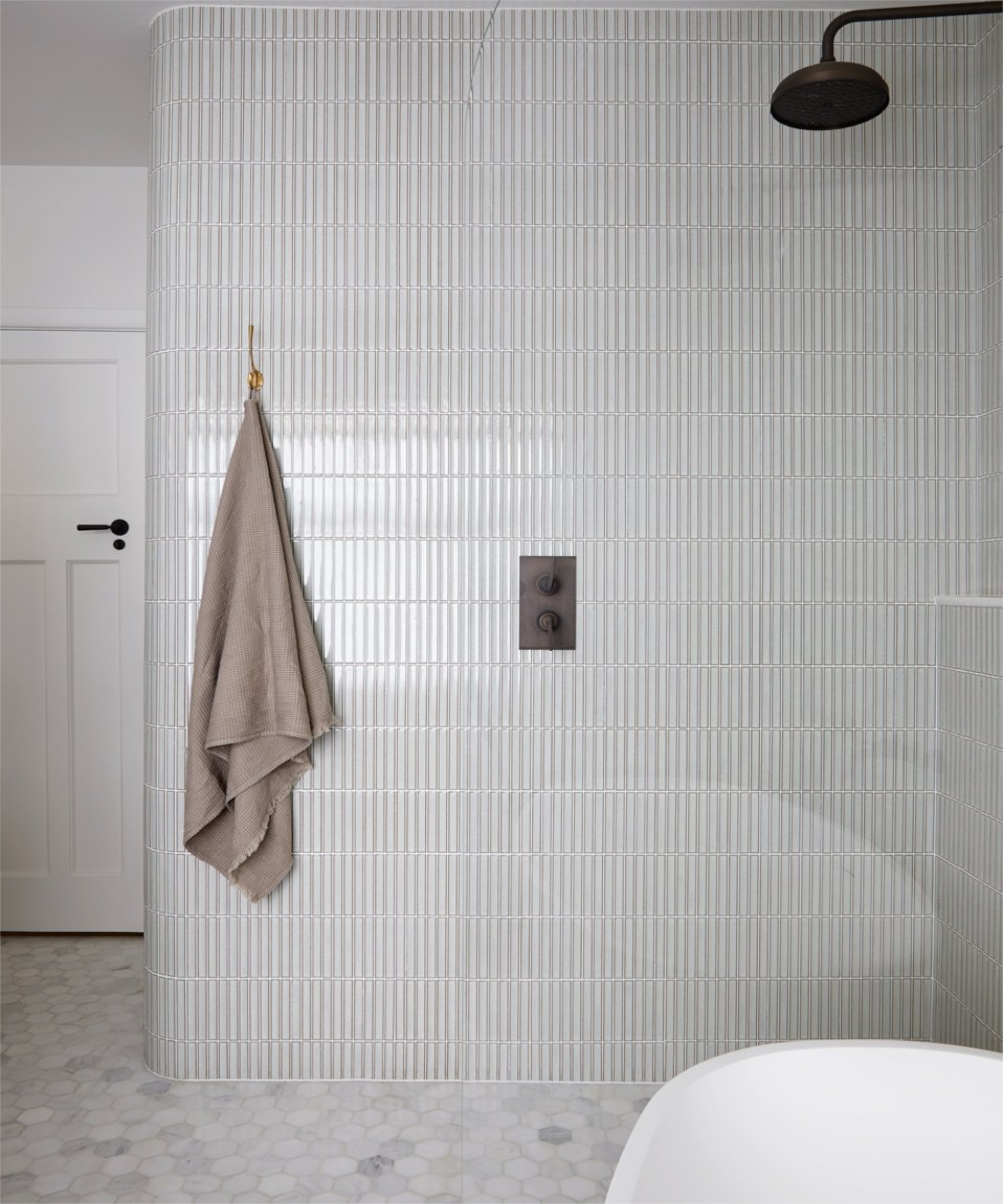
'For us, an accent or feature wall needn't be loud colors or wild pattern,' explains Caroline Sacreste, Co-founder, Indie & Co. 'We love to bring a room to life using subtle texture or curves. This can be achieved by using materials such as mosaic or zellige tiles or a different plaster or limewash paint ideas. This brings interest and depth to a space without being overbearing.'
8. Focus on woodwork

Trim is a fantastic way to create an accent. 'Original woodwork and features such as skirting, architraves, doors and window frames look good highlighted – often by going a shade darker than the wall color,' says Tiffany Duggan of Studio Duggan.
'As a living room color idea, this works especially well in larger rooms whereas in smaller rooms, I often use the same paint color on both walls and woodwork to provide a calmer base that allows furniture and fabrics to really sing.'
9. Boost your Zoom background
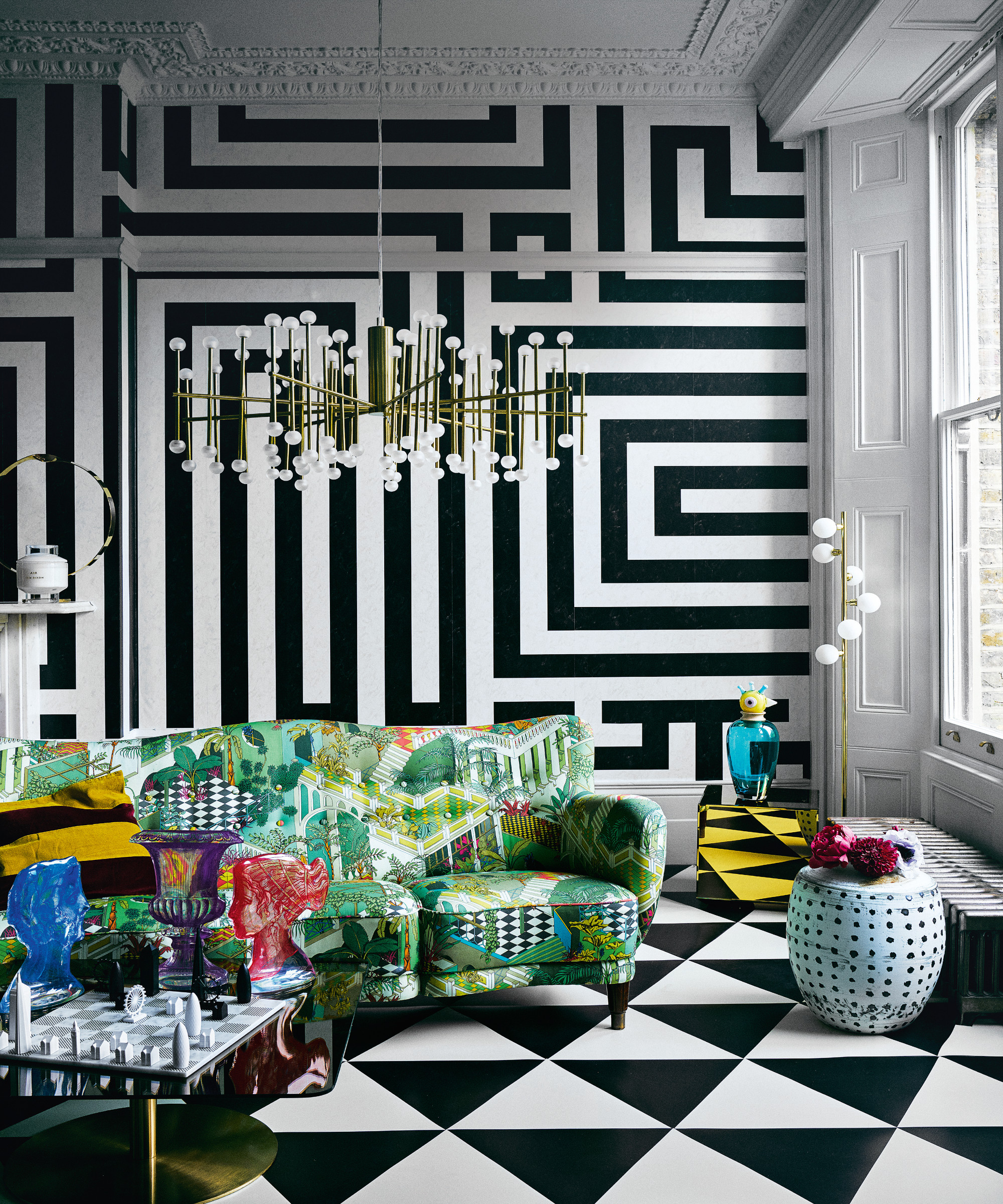
Avoid putting an accent wall in an already overcrowded room. When there is too much going on in a space, it can be confusing to the eye and create a sense of chaos – unless that's the look you're going for of course. A feature wall should be a highlight, so it needs room to breathe. Although the pattern is busy in this scheme, the colors are the same and the woodwork and ceiling are kept white, ensuring the whole room is unified.
'I love accent walls. Many times, clients want to do something bold and fun, but are scared to commit and that's where the accent wall comes into play,' says Ruchi A Mohan, Founder of DesignbyRUCHI. 'It is the focal point in the room, a place for the eye to get drawn to, a potential Zoom background, and it also reduces pressure on the budget. It is an opportunity for creativity.'
10. Frame your bed
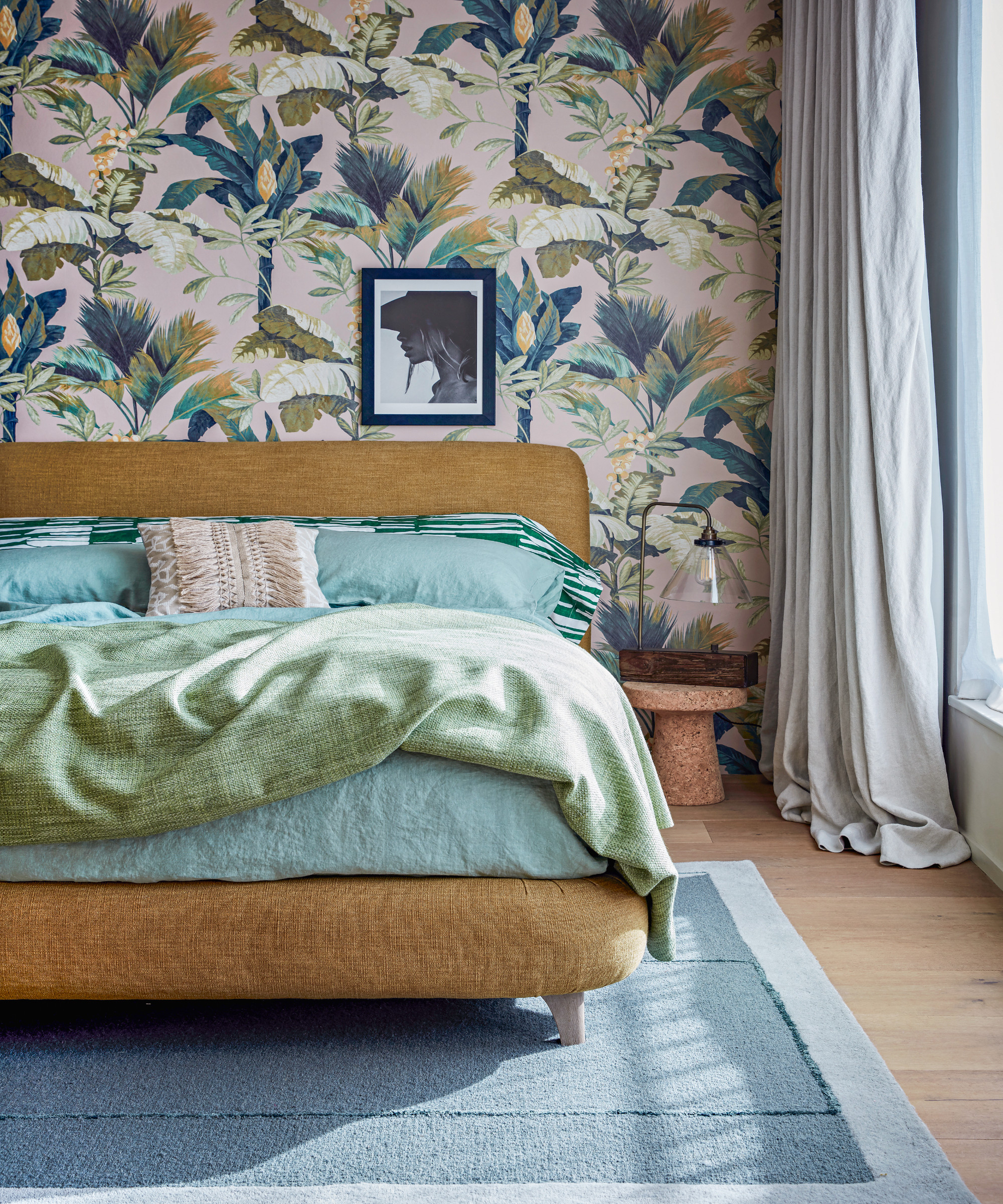
Don't just randomly select a wall to highlight. The feature wall should be used to highlight the room's existing focal point. For instance, the wall where the fireplace sits, or even where the TV is, makes for a good feature wall. The wall behind the headboard in a bedroom is also ideal.
Use an accent wall to create a frame or headboard for your bed, whether that's an all-over pretty floral print as a backdrop or something more modern, like a painted headboard which could change the look of your bedroom ideas, giving it a new color scheme and a new focal point. Plan out your design first using a pencil and then get painting. Remember if you go wrong you can always paint over it, so get creative.
11. Paint the fifth wall

'We love painting the ‘5th wall’ whereby it adds another dimension and playfulness to the room that's often forgotten about,' says Kate Clare, founder of Loud Architects. 'Darker colors bring the room down whilst lighter ones and ones the same color as the wall make the room feel taller. I like to pick up the color of the walls on the ceiling too, or if using a wallpaper then pick out colors of that and paint the walls.'
12. Try a mural
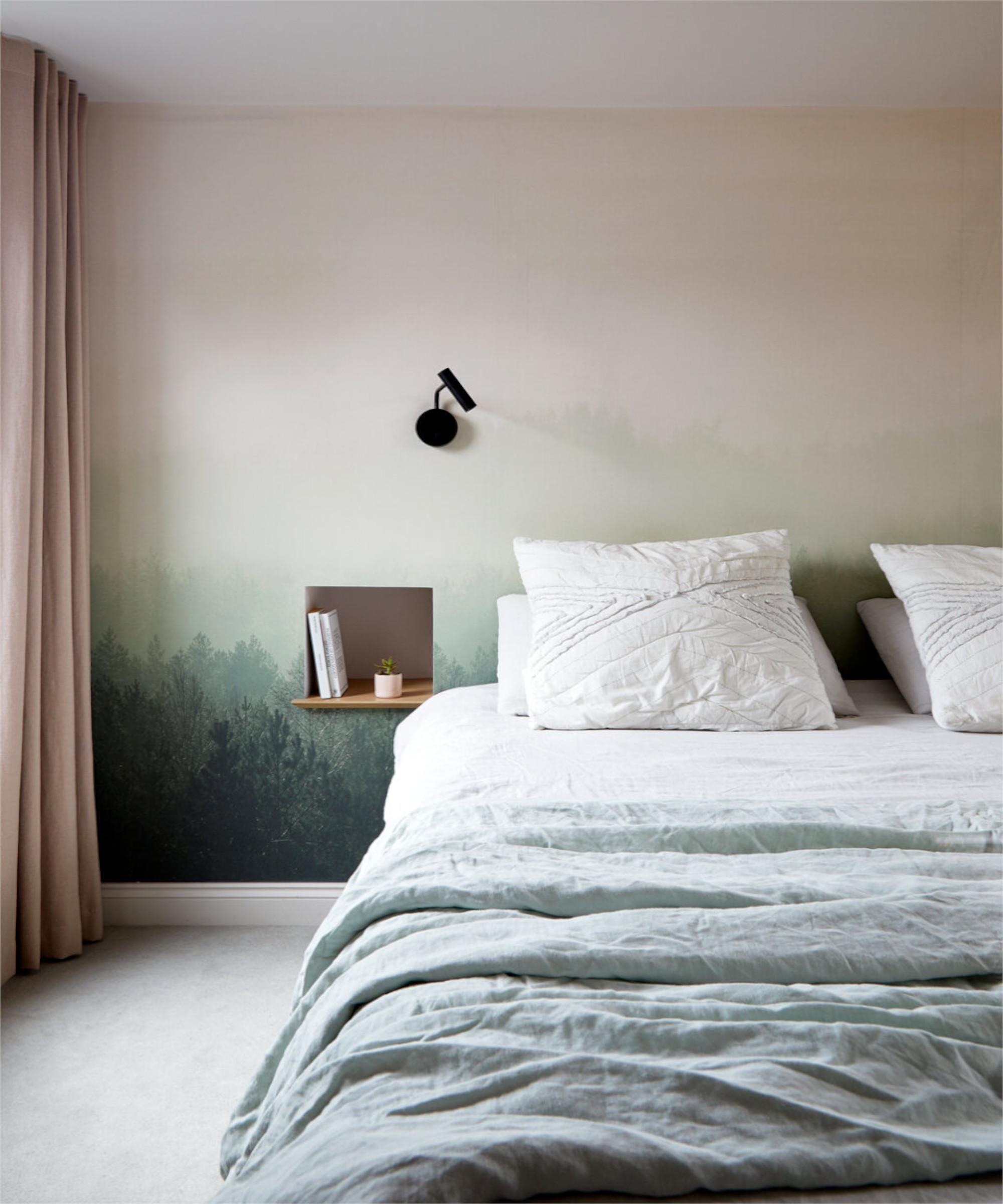
'To create a sense of escapism in this calm and mindful bedroom, we commissioned an accent wall mural to be painted on the wall which picks up subtly on the other colors in the room,' explains Caroline Sacreste, Co-founder, Indie & Co. 'The landscape mural adds depth and a dream-like quality to the room which helps support relaxation and offers a place of sanctuary within the home.'
Chris McGovern, principal designer of McGovern Project also adds that, 'wallpaper murals are great for a single accent wall or as an alternative to a wallpaper. I prefer to use wallpaper murals where there are few obstructions on the wall. It allows one to fully appreciate the subject matter of the mural and minimizes waste. Conversely, a wallpaper with a much smaller repeat pattern on a blank accent wall can sometimes feel busy on a wall, especially with no windows or doors.'
'Options range at different price points from companies such as Rebel Walls which can digitally print to a customer's size and scale in a relatively short lead time to custom hand painted wall panels made to your space, most notably from Gracie Studios or de Gournay. Wherever your budget lies, consider that few pieces of art or wall decor are needed on those walls. When using murals on a single wall, coordinating paint colors on other walls, trim, and even doors and in textiles and soft goods can help create a harmonious look.'
What is the rule for accent walls?
Typically it's best to follow the 60-30-10 rule which is a classic decor rule that helps create a color palette for a space. It states that 60% of the room should be the dominant color, 30% should be the secondary color, and 10% should be an accent color. So when choosing an accent color you'll want something that's different from the 60% and 30% colors. A classic interior design trick to ensure a perfect color scheme every time.
'Using two or three shades is an easy device to divide the space and encourage the sense of something more architectural in feel, without the need for costlier building work,' says Rob Whitaker of Claybrook. The upper wall, often in a lighter tone, can be utilized for hanging favorite art, key fobs or a coat rack. Using a bold pop of color can also be a brilliant way to have a bit of fun with your scheme.'

Do accent walls make room smaller?
In a small room, yes an accent wall can make it feel even smaller, but generally, accent walls can make rooms feel larger because they add extra detail, helping to break up the space and give us more to look at.
Making a room feel small smaller or cozier isn't always a bad thing, especially if you want to break up an open-plan space with room divider ideas. Use an accent wall to define a living space. In an open concept home or multiple-use spaces it can be tricky to define areas, but an accent wall can help.
'When using wallpaper to accent a wall, making it work with the paint color in the room is key,' says Caroline Sacreste, Co-founder, Indie & Co. 'Here, we chose Farrow & Ball Railings which works beautifully with the House of Hackney wallpaper so that the feature wall is not too loud in the space and instead blends perfectly with the dark feel of the room.'
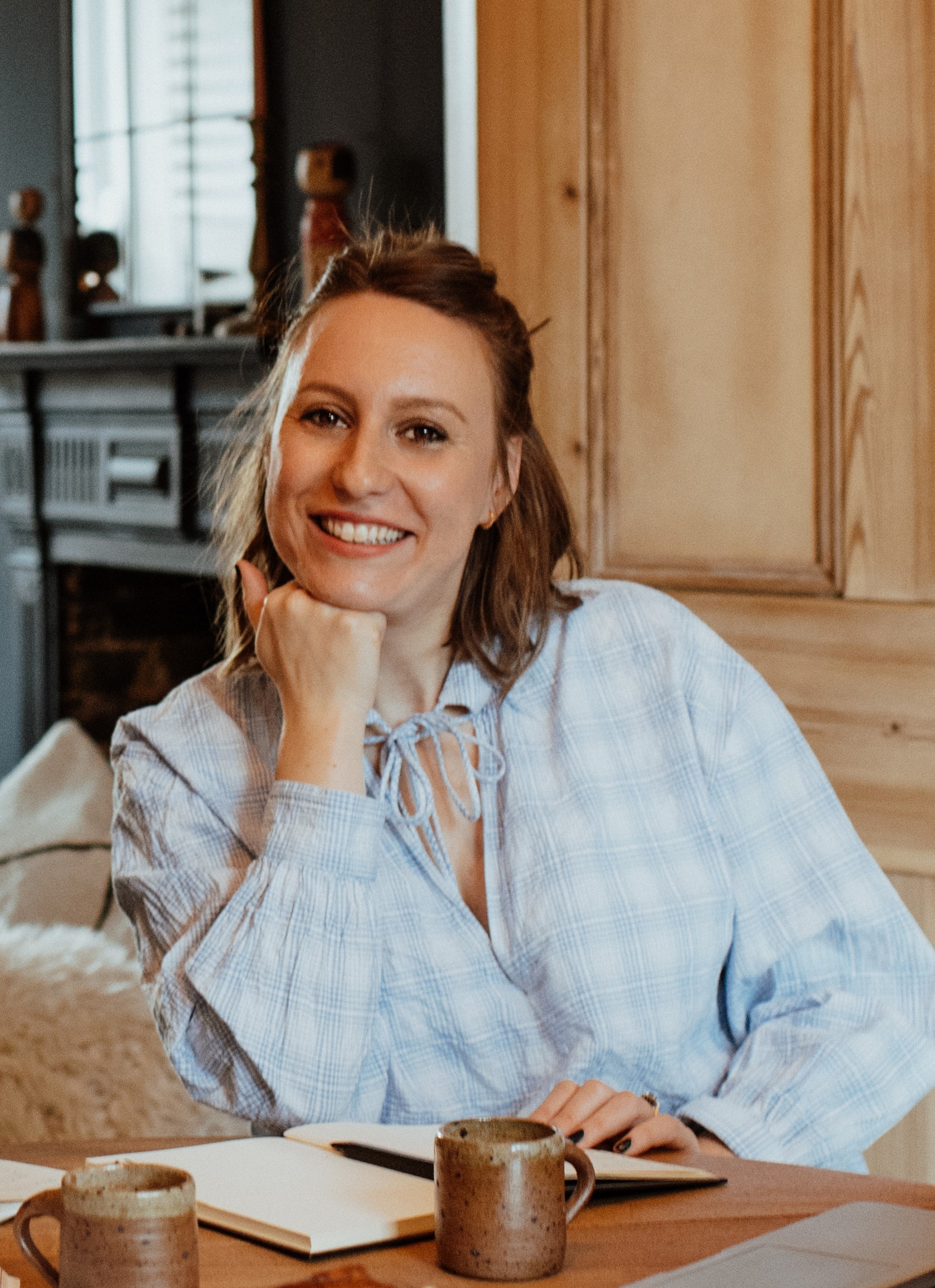
As the Houses Editor on Livingetc, Rachel has been obsessed with property ever since she was a kid. With a diploma in interior design and more than a decade working on interior magazines under her belt, she feels very at home sourcing the best contemporary houses the world has to offer for Livingetc. It's not just the day job either, she admits she's spent a scary amount of her own time researching schemes for her own renovations - scrolling Instagram, stalking Rightmove and Modern House, flicking through magazines and snooping in other peoples' windows - so she really does live and breathe houses on a daily, if not hourly, basis. Before Livingetc, Rachel had a stint finding homes for Ikea Family magazine where she was lucky enough to gallivant around the world on shoots meeting and interviewing interesting people, all with a very keen eye for blending high-end design with everyday items from Ikea. It inspired her to not be afraid of mixing new and old, expensive and affordable, vintage and modern and so Rachel's current Victorian terrace in north London is very much an updated, contemporary take on a period property; think open-plan modern kitchen with concrete floors, feature fireplaces and her grandmother’s paintings on the walls. Rachel is currently crushing on reeded glass, large gingham prints, squishy curved furniture; like Buchanan Studio’s Studio chair, and vintage wall sconces; she especially adores Retrouvius for sourcing antique finds and feels inspired by Lonika Chande, Beata Heuman and Matilda Goad and already can’t wait to start planning her next home, wherever that might be.